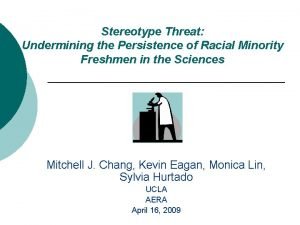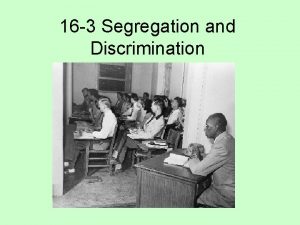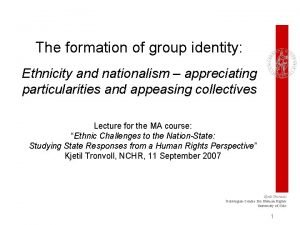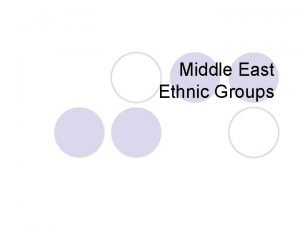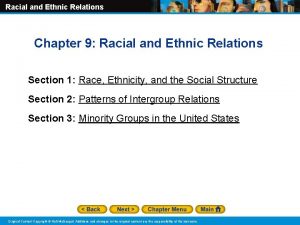Lifecourse Social Conditions and Racial and Ethnic Patterns



































- Slides: 35

Lifecourse Social Conditions and Racial and Ethnic Patterns of Cognitive Aging Jennifer Manly APHA Oct 2016

Presenter Disclosures Jennifer Manly, Ph. D (1) The following personal financial relationships with commercial interests relevant to this presentation existed during the past 12 months: No relationships to disclose

Collaborators Maria Glymour Adam Brickman Christopher Weiss Karen Siedlecki Wei-Ming Watson Laura Zahodne Sze Liu Yaakov Stern Richard Mayeux Nicole Schupf Supported by • NIA R 01 AG 16206, AG 028786, RF 1 AG 054070 (PI: Manly) • NIA R 01 AG 037212 (PI: Mayeux)

Overview • Evidence for disparities in cognitive aging and Alzheimer’s disease • Methodological challenges to AD disparities research • Prevalence vs. incidence • Intercept vs. slope • Neuropsychological assessment across racial/linguistic groups • Selection bias • Survival effect and possible crossover effect • Lifecourse social mechanisms of racial disparities in AD

Washington Heights/Hamilton Heights/Inwood Columbia Aging Project (WHICAP) INWOOD • N = 2125 in 1992, added 2174 in 1999 WASHINGTON • Age 65 and older HEIGHTS • Women (68%) outnumbered men (32%), consistent HAMILTON HEIGHTS with age group • Tested in Spanish (37%) or English (63%) • Seen in home at 18 – 24 month intervals • Dx based on neuropsychological test battery, medical & functional interview 40 Percent of cohort 30 20 10 0 Caucasian African American Hispanic

Annual age-specific incidence Evidence of Disparities Incidence of AD by Age and Race/Ethnicity WHICAP 2001 Tang et al. , 2001; Neurology 56: 49 -56

Evidence of Disparities Prevalence of Cognitive Impairment by Age and Race/Ethnicity HRS 2006 Alzheimer’s Association, 2010

Evidence of Disparities Kaiser Permanente Northern California Mayeda et al. , 2016

Methodological challenges to disparities research on cognitive aging and dementia

Selection Bias • Differences in recruitment across racial/ethnic groups may lead to non-generalizable results • Ethnic minority participants may not be broadly representative of the community • Consider how barriers to participation may influence sample characteristics and bias results • Racial and ethnic minorities are less likely to present to Memory Disorders Clinics, are less likely to receive a formal diagnosis of AD than non. Hispanic Whites • Minorities who present to clinics are more likely to have neuropsychiatric symptoms than Whites

Racial differences in mixed pathology in black and white decedents with Alzheimer disease (AD) dementia Barnes et al. Neurology 2015

Survival Bias • Mortality is higher, at all ages, among racial/ethnic minorities and those with low education as compared to Whites/high educated • The smaller group of people of color who live to be studied as older adults are hardier than the larger group of Whites. • Hardiness is probably related to an unobserved characteristic. • Even if the unmeasured factor was not initially related to race (for example, specific genes), selective survival could bias estimates of the effect of race on mortality, both exaggeration or reversal of the effect of race on mortality can occur • This bias is not just present for mortality but for any health outcome that can occur just once (like dementia) Glymour, Weuve, & Chen (2008)

WHICAP Evidence for age-as-leveler effects Zahodne, Manly, Azar, Brickman, & Glymour, JAGS (2016)


Memory composite score (z-score) Blacks and Hispanics have more rapid memory decline as compared to Whites in WHICAP 0 -0, 2 Time (years) 0 2 -. 341 point difference between non-Hispanic Whites and Blacks 4 6 -0, 4 -0, 6 -0, 8 -1 -1, 2 non-Hispanic White non-Hispanic Black Hispanic -. 341 point differenc

Memory composite score (z-score) Blacks and Hispanics have more rapid memory decline as compared to Whites in WHICAP 0 -0, 2 Time (years) 0 2 -. 341 point difference between non-Hispanic Whites and Blacks 4 6 -0, 4 “Diagnostic threshold” -0, 6 -0, 8 -1 -1, 2 non-Hispanic White non-Hispanic Black Hispanic -. 341 point differenc

Causal pathways linking race, cognitive aging, and AD History Genetic Ancestry Self or Other Identified Race Social Factors Behaviors Biological factors Cognitive Decline Alzheimer’s Disease Birth Region Adapted from Marden et al. , 2016

Biological Mediators of AD Disparities: Age, ethnicity, and relative WMH volume Brickman et al. , Arch Neurol, 2008

WMH & language Zahodne et al, CAR 2015

Hippocampal vol. & incident dementia Hippocampal volume below sample mean Hippocampal volume at or above sample mean Non-Hispanic White Non-Hispanic Black

Admixture mapping • Higher levels of African ancestry (whole genome level and at specific AD-related genetic loci like ABCA 7) are associated with an increased risk for AD Hohman et al. , 2015

Social factors correlate with African Ancestry and could confound relationship with AD • HRS non-Hispanic blacks • Comparing highest versus lowest quartile of African Ancestry • Higher African Ancestry is associated with • • • Marden, Walter, Kaufman, & Glymour, (2016) Less education Fewer years of parental schooling No inheritance Lower income (about $1400/year) Less wealth (about $12, 000) • Ancestry doesn't biologically mediate or influence these factors • African ancestry is a marker for social experiences of individual, parents and grandparents Accounting for socioeconomic status eliminated the association of European ancestry with lower risk of diabetes Colombia and attenuated the association in Mexicans (Flores et al. , 2009)

School Quality • Educational attainment (years or credential) ignores tremendous variability in quality of schooling • Race/ethnicity • Geographic region • Secular trends

Length of School Year

Student Teacher Ratio

Determinants of cross-sectional language test performance *** *** *** All models are adjusted for age and sex *** ***

Alabama counties of residence during participants’ childhood schooling • Student–teacher ratio and school year length, not expenditures, were associated with baseline cognitive function • Independent of education level, age, race, gender, income, reading ability, vascular risk factors, and health behaviors • Associations were stronger in those with lower levels of education (≤ 12 years) • Not related to 4 -year change in Michael Crowe et al. J Gerontol A Biol Sci Med Sci cognitive function 2012

Racial disparities by US region of primary school education in HRS Liu, Glymour, Zahodne, Weiss, & Manly, JINS (2015)

Reading level and Memory Manly et al. , JCEN 2003

Disparities in WHICAP Watson et al. , in preparation

Mechanisms of AD Disparities in WHICAP Watson et al. , in preparation

Secular Trends in AD incidence by race Schupf et al. , under review Model 1 Model 2 Model 3 HR (95%CI) 1999 0. 59 (0. 49 -0. 72) 0. 62 (0. 50 -0. 77) 0. 69 (0. 55 -0. 86) 1992 1. 0 (ref) 1999 0. 60 (0. 34 -1. 05) 0. 72 (0. 35 -1. 47) 0. 80 (0. 37 -1. 71) 1992 1. 0 (ref) 1999 0. 52 (0. 36 -0. 73) 0. 65 (0. 44 -0. 97) 0. 87 (0. 57 -1. 34) 1992 1. 0 (ref) 1999 0. 64 (0. 49 -0. 83) 0. 60 (0. 45 -0. 79) 0. 62 (0. 47 -0. 83) 1992 1. 0 (ref) 1. 00 (ref) All Participants Non-Hispanic White African-American Hispanic Model 1 Including cohort as predictor, adjusted for age, sex, race/ethnicity, baseline memory complaints Model 2: Model 1 plus diabetes, heart disease, stroke, hypertension, current smoking, and BMI Model 3: Model 2 plus education

Racial difference in benefit from cognitive intervention is mediated by psychosocial factors: ACTIVE trial Zahodne, et al. (2015)

Conclusions • There are racial disparities in cognitive aging and AD • Not attributable to assessment bias, although this is a major factor in some studies • The independent effect of race on cognitive function is larger on intercept (cross-sectional) than on slope or change over time (longitudinal) • Differences across studies may be attributable to differential recruitment, selection, and survival bias • Declining trend of dementia incidence among African Americans is explained by secular increases in years of school • Clinic-based cohorts are not appropriate for research on AD disparities • Biological, environmental, and sociocultural mediators of disparities have been examined • Indicators of school quality explain racial disparities in cognitive function cross-sectionally and longitudinally, and AD incidence • Intervening on psychosocial factors may narrow disparities in cognitive decline and improve response to interventions • Sociocultural factors correlate with African Ancestry and may confound relationship of African Ancestry with AD risk or age at onset

Understanding the mechanisms of dementia disparities • Conduct studies designed to elucidate causal mechanisms • Longitudinal studies • baseline prior to development of dementia (midlife or prior) • repeat cognitive assessment • importance of incidence and trajectory data • Measure educational experience, not just years attended or credential • Measure burden of neuropathology • Follow up into mid-life and later life needed for school, twin, and birth cohorts • Investigate potential critical periods (elementary vs. secondary; later life learning) • Evaluate natural experiments using instrumental variables • ADRD outcomes incorporated within planned interventions • Increased income • Improving neighborhood and household • Values affirmation reduces stereotype threat/perceived racism
 Chapter 10 racial and ethnic relations review worksheet
Chapter 10 racial and ethnic relations review worksheet Chapter 10 racial and ethnic relations
Chapter 10 racial and ethnic relations Chapter 10 racial and ethnic relations review worksheet
Chapter 10 racial and ethnic relations review worksheet Black studies and the racial mountain
Black studies and the racial mountain Racial etiquette region
Racial etiquette region Racial wealth gap simulation
Racial wealth gap simulation Promoting racial literacy in schools
Promoting racial literacy in schools Racial theories apush
Racial theories apush Racial prejudice
Racial prejudice Don tiburcio noli me tangere
Don tiburcio noli me tangere Racial insults
Racial insults In what region did racial etiquette exist
In what region did racial etiquette exist Cartel ley organica contra la discriminacion racial
Cartel ley organica contra la discriminacion racial Democracia racial
Democracia racial Lesson 2 racial discrimination
Lesson 2 racial discrimination Associations and correlations in data mining
Associations and correlations in data mining Dating serves several important functions that include:
Dating serves several important functions that include: Social thinking adalah
Social thinking adalah Social thinking social influence social relations
Social thinking social influence social relations Eyinar meaning in tamil
Eyinar meaning in tamil Ethnicity in postcolonial literature
Ethnicity in postcolonial literature Internal factors and ethnic differences in achievement
Internal factors and ethnic differences in achievement Whats an ethnic group
Whats an ethnic group How are ethnic groups and religious groups related
How are ethnic groups and religious groups related Sikhism universalizing or ethnic
Sikhism universalizing or ethnic Cultural geography of the middle east
Cultural geography of the middle east Ethnic boundary marker
Ethnic boundary marker Nadia kajouji ethnic background
Nadia kajouji ethnic background Madrid absolute location
Madrid absolute location Diffusion of judaism ap human geography
Diffusion of judaism ap human geography Proselytic religion definition
Proselytic religion definition Ethnic formation
Ethnic formation Ethnic dialect
Ethnic dialect Nation vs state
Nation vs state Ethnic groups in the middle east
Ethnic groups in the middle east Ethnic groups cloze notes 1 answer key
Ethnic groups cloze notes 1 answer key










